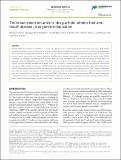Files in this item
The broad-spectrum antiviral drug arbidol inhibits foot-and-mouth disease virus genome replication
Item metadata
| dc.contributor.author | Herod, Morgan R. | |
| dc.contributor.author | Adeyemi, Oluwapelumi O. | |
| dc.contributor.author | Ward, Joseph | |
| dc.contributor.author | Bentley, Kirsten | |
| dc.contributor.author | Harris, Mark | |
| dc.contributor.author | Stonehouse, Nicola J. | |
| dc.contributor.author | Polyak, Stephen J. | |
| dc.date.accessioned | 2019-08-08T10:30:03Z | |
| dc.date.available | 2019-08-08T10:30:03Z | |
| dc.date.issued | 2019-09-01 | |
| dc.identifier | 260441369 | |
| dc.identifier | 651626d1-d4eb-44d6-b45a-aa66ad82f450 | |
| dc.identifier | 000484368500006 | |
| dc.identifier | 85071783451 | |
| dc.identifier.citation | Herod , M R , Adeyemi , O O , Ward , J , Bentley , K , Harris , M , Stonehouse , N J & Polyak , S J 2019 , ' The broad-spectrum antiviral drug arbidol inhibits foot-and-mouth disease virus genome replication ' , Journal of General Virology , vol. 100 , no. 9 , pp. 1293-1302 . https://doi.org/10.1099/jgv.0.001283 | en |
| dc.identifier.issn | 0022-1317 | |
| dc.identifier.other | ORCID: /0000-0002-6619-2098/work/60427672 | |
| dc.identifier.uri | https://hdl.handle.net/10023/18271 | |
| dc.description | This research was partially supported by a Cheney Fellowship to S. J. P. from the University of Leeds. Support from BBSRC grant BB/P001459/1 to N. J. S. and BBSRC Studentship BB/F01614X/1 to J. W. is also gratefully acknowledged. | en |
| dc.description.abstract | Arbidol (ARB, also known as umifenovir) is used clinically in several countries as an anti-influenza virus drug. ARB inhibits multiple enveloped viruses in vitro and the primary mode of action is inhibition of virus entry and/or fusion of viral membranes with intracellular endosomal membranes. ARB is also an effective inhibitor of non-enveloped poliovirus types 1 and 3. In the current report, we evaluate the antiviral potential of ARB against another picornavirus, foot-and-mouth disease virus (FMDV), a member of the genus Aphthovirus and an important veterinary pathogen. ARB inhibits the replication of FMDV RNA sub-genomic replicons. ARB inhibition of FMDV RNA replication is not a result of generalized inhibition of cellular uptake of cargo, such as transfected DNA, and ARB can be added to cells up to 3 h post-transfection of FMDV RNA replicons and still inhibit FMDV replication. ARB prevents the recovery of FMDV replication upon withdrawal of the replication inhibitor guanidine hydrochloride (GuHCl). Although restoration of FMDV replication is known to require de novo protein synthesis upon GuHCl removal, ARB does not suppress cellular translation or FMDV internal ribosome entry site (IRES)-driven translation. ARB also inhibits infection with the related Aphthovirus, equine rhinitis A virus (ERAV). Collectively, the data demonstrate that ARB can inhibit some non-enveloped picornaviruses. The data are consistent with inhibition of picornavirus genome replication, possibly via the disruption of intracellular membranes on which replication complexes are located. | |
| dc.format.extent | 10 | |
| dc.format.extent | 1647232 | |
| dc.language.iso | eng | |
| dc.relation.ispartof | Journal of General Virology | en |
| dc.subject | Indole | en |
| dc.subject | Antiviral | en |
| dc.subject | FMDV | en |
| dc.subject | Arbidol | en |
| dc.subject | ERAV | en |
| dc.subject | Piconavirus | en |
| dc.subject | QR355 Virology | en |
| dc.subject | RM Therapeutics. Pharmacology | en |
| dc.subject | NDAS | en |
| dc.subject | SDG 3 - Good Health and Well-being | en |
| dc.subject.lcc | QR355 | en |
| dc.subject.lcc | RM | en |
| dc.title | The broad-spectrum antiviral drug arbidol inhibits foot-and-mouth disease virus genome replication | en |
| dc.type | Journal article | en |
| dc.contributor.institution | University of St Andrews. School of Biology | en |
| dc.contributor.institution | University of St Andrews. Biomedical Sciences Research Complex | en |
| dc.identifier.doi | 10.1099/jgv.0.001283 | |
| dc.description.status | Peer reviewed | en |
This item appears in the following Collection(s)
Items in the St Andrews Research Repository are protected by copyright, with all rights reserved, unless otherwise indicated.

